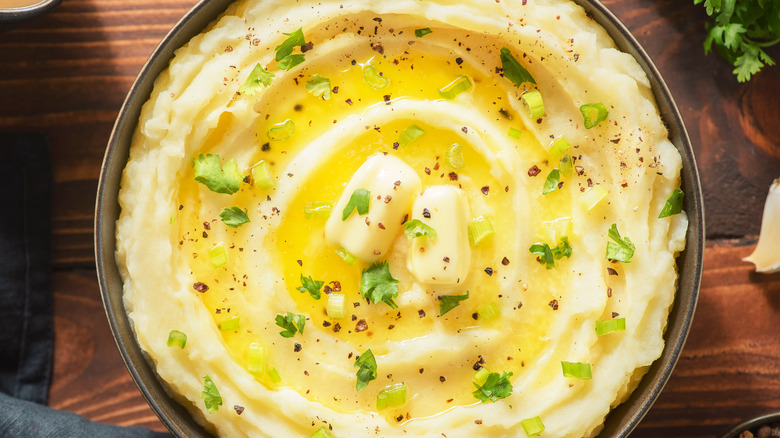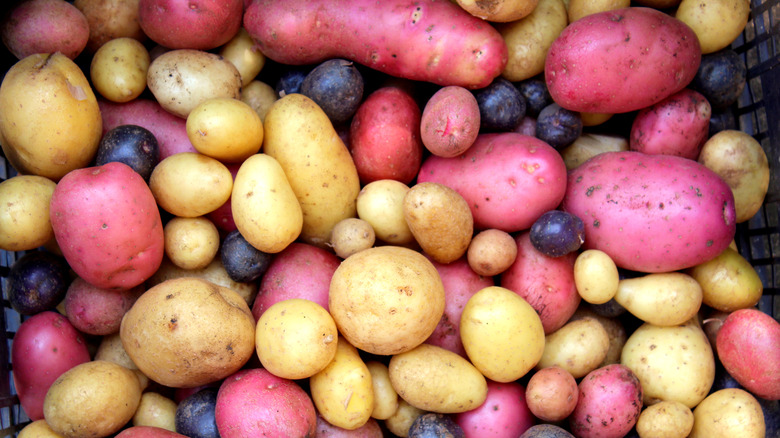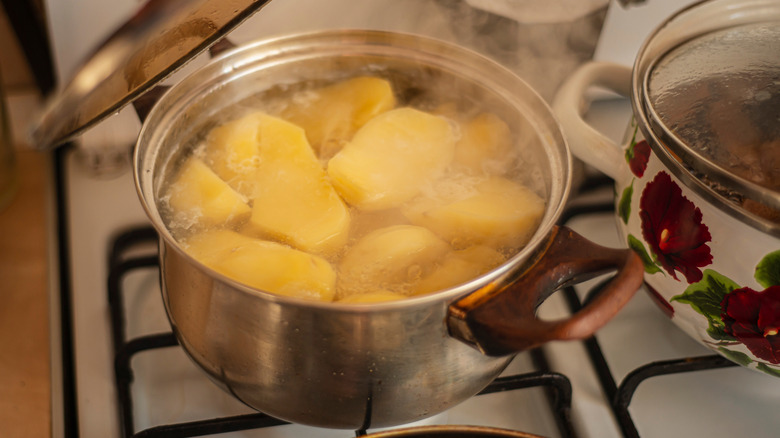The Key To The Best Mashed Potatoes? Using Different Types Of Spuds
Most people can agree that mashed potatoes are delicious, but not everyone has the same opinions on how to make them. From the type of consistency you enjoy — from fluffy to chunky to creamy mashed potatoes — to how you should garnish this popular side dish, the best mash is definitely down to personal preference. One of the biggest points of contention is what kind of potatoes should be used, and the best answer — in our opinion — may be unexpected.
Some argue that the fluffiest, starchiest kinds of potatoes like russets are the best for a mash, while others claim that waxy Yukon Golds are better, due to their innate buttery flavor and creamy texture. So, which spuds should you use? To achieve the best and most balanced qualities in your mashed potatoes, we suggest that you use multiple different types of spuds in each batch of this beloved dish. Using a mix of popular potatoes will ensure that you get the most well-rounded and creamy-yet-fluffy mashed potatoes possible. Here's what using a variety of spuds does for you and your favorite side dish.
Why you should use multiple kinds of potatoes
If you're unsure of which spuds you'll most enjoy in homemade mashed potatoes, reap the benefits of more than one variety. Russet and Yukon gold potatoes are a great combination to use, as they each offer their own perks. Russet potatoes contain a lot of starch and become extra fluffy after they've been mashed. Their uniquely high starch content heavily affects the texture of your mashed potatoes, and they also boast a more mild, earthy flavor that makes for a wholesome-tasting dish.
Meanwhile, Yukon Golds have a medium starch content, and they offer much more in terms of flavor. These potatoes are very rich in taste and buttery all on their own, and are usually labeled as an "all-purpose" potato because they're balanced and versatile. They also have thin skins, which makes them an ideal choice if you plan to leave your potatoes unpeeled. In that case, use slightly more Yukon Golds than russets, or just peel your russets, but don't bother to peel the Yukons.
More rare potato varieties can also be used for mashed potatoes, but you should steer clear of very "waxy" potatoes, which are hard to mash and can make your mashed potatoes too chunky or dense. Waxy varieties include Dutch Cream, Kipfler, Southern Gold, purple potatoes, and more. Once you've got your potatoes picked, you can upgrade your recipe even further using whatever tricks sound good to you, and you'll have your ideal mash.
Other ways to elevate your favorite side dish
Another surefire way to boost the flavor of your mashed potatoes is to boil your spuds in broth before mashing them. You already have to boil your spuds in water, so why not make a simple switch to broth to add extra flavor to the potatoes? Whether you use beef broth or chicken, the choice is up to you. Just keep in mind that different potato varieties may cook through at different times, so keep a close eye on the pot if you use two or more varieties.
There's another way to ensure more even cooking. Before you add your potatoes to a boiling pot, remember not to cut them too thin or small. Potatoes that are cut too small will lose their flavor and texture quickly when exposed to boiling water, so try to merely quarter your potatoes (unless they're very large) or leave small baby potatoes whole. It might take longer for bigger chunks of potatoes to boil, but the best results take time, so be patient.
Finally, don't be stingy with your flavorings and toppings. From hearty slabs of butter to fresh cracks of black pepper to chopped green onions, a few finishing touches can truly make or break this dish, so don't skimp on anything, especially the butter. With all these tips in mind, you'll have a bowl of the dreamiest mashed potatoes you can imagine.


